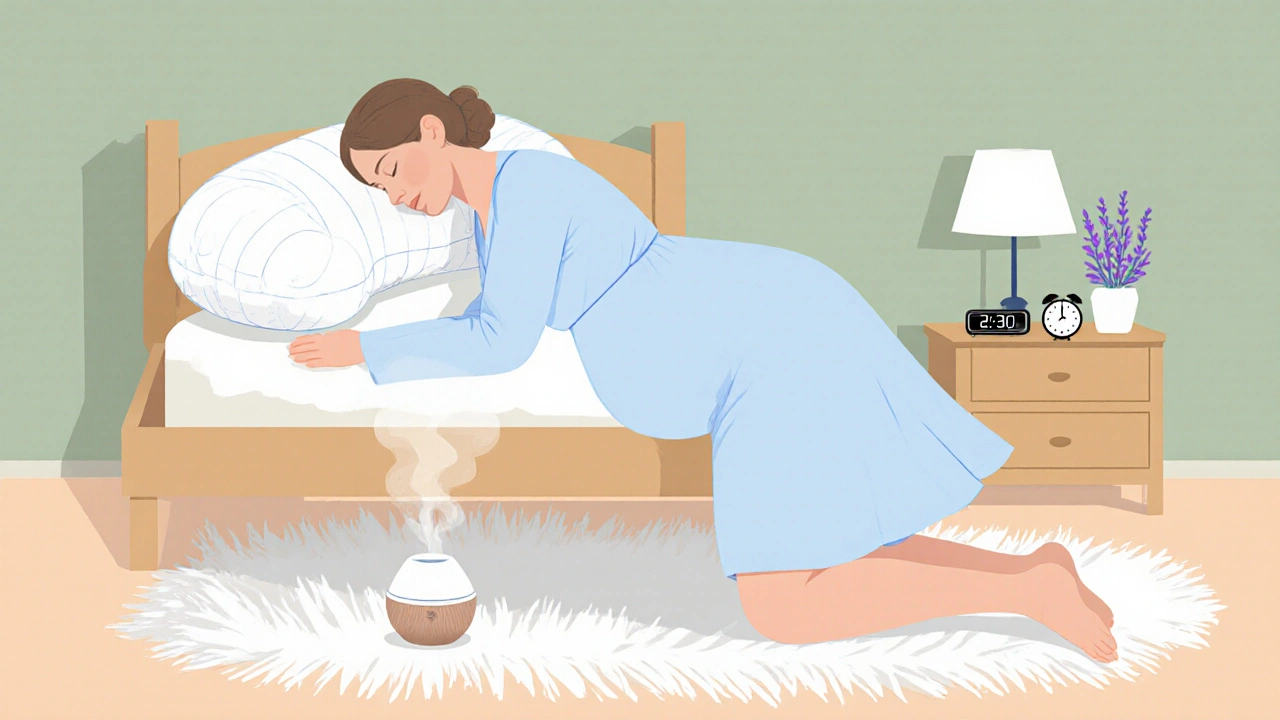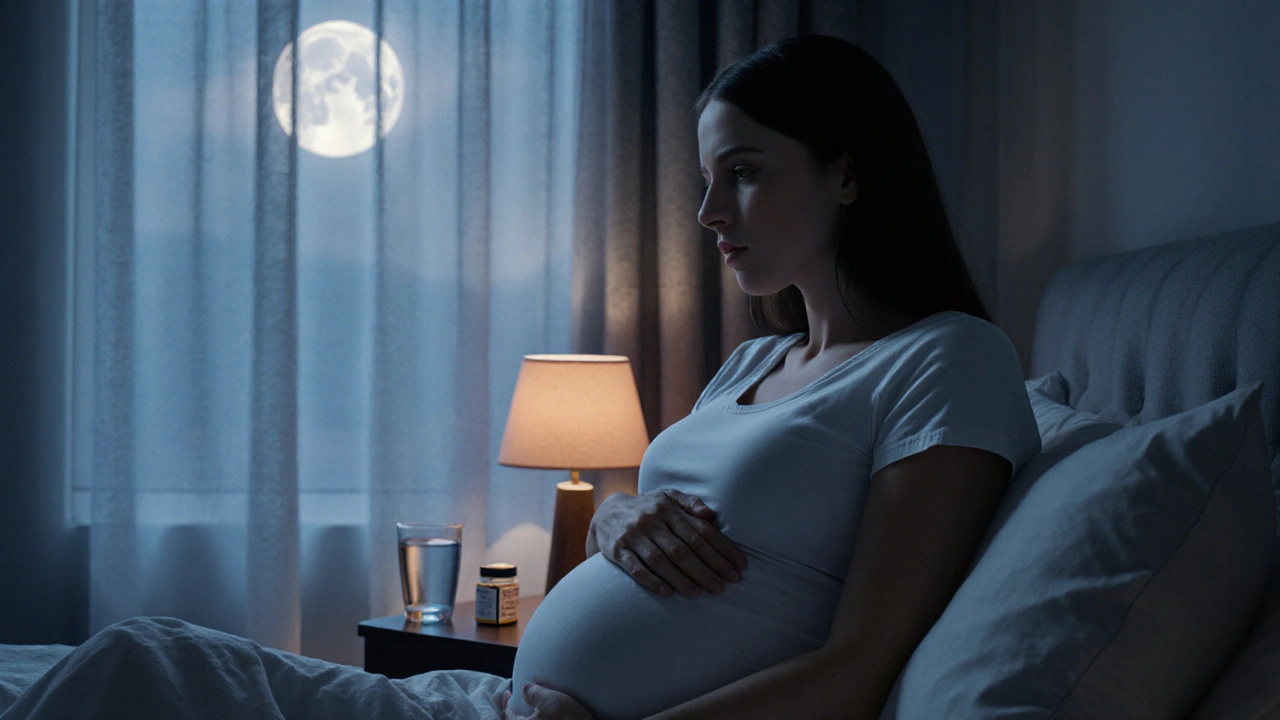Pregnancy Sleep Tips: How to Get Better Rest at Night
Pregnancy Sleep Position Advisor
Optimize Your Sleep Position
Get personalized recommendations based on your pregnancy stage and symptoms
Recommended Position:
When you’re expecting, Pregnancy a 40‑week condition where a fertilized egg develops into a baby inside the uterus brings a lot of changes that can mess with your Sleep the natural, reversible loss of consciousness and reduced metabolic activity that restores body functions. Hormone shifts, a growing belly, and night‑time discomforts often turn bedtime into a guessing game. Below are practical, doctor‑backed tips to help you reclaim quality rest without resorting to pills.
Key Takeaways
- Sleep needs rise to 7‑9hours in the second and third trimesters, but quality matters as much as quantity.
- Left‑side sleeping eases circulation; a pregnancy pillow can keep you comfortable.
- Simple routine tweaks-cool room, limited fluids, and gentle stretches-reduce night awakenings.
- Address common issues like heartburn, restless legs, and frequent urination with targeted strategies.
- Seek professional help if you experience snoring, gasping, or persistent insomnia.
Why Sleep Changes During Pregnancy
During the first trimester, Hormones chemical messengers like progesterone and estrogen that regulate body functions rise sharply. Progesterone relaxes muscle tone, which can make the airway slightly more relaxed and trigger snoring. At the same time, your body produces more Melatonin the hormone that signals darkness and helps regulate the sleep‑wake cycle, but the surge can feel uneven, leading to fragmented sleep.
In the second trimester the fetus starts growing, pushing against the diaphragm and squeezing the stomach. This pressure can cause Heartburn a burning sensation in the chest caused by stomach acids moving up the esophagus and make it harder to lie flat. By the third trimester the belly takes up most of the bed, forcing you to shift positions frequently and waking you up for bathroom trips.

Build a Consistent Bedtime Routine
A predictable routine tells your brain it’s time to wind down. Start 30minutes before lights out with these steps:
- Cool the room to about 18°C (65°F). A cooler environment encourages deeper sleep cycles.
- Turn off screens or use a blue‑light filter. The light suppresses melatonin and can delay sleep onset.
- Do a short stretch series focused on the back, hips, and legs. Gentle yoga poses such as Cat‑Cow and Child’s Pose relieve tightness that often spikes after a day of standing.
- Practice a relaxation technique-deep breathing, progressive muscle relaxation, or a simple gratitude list.
- Limit fluids to a reasonable amount after dinner, but stay hydrated throughout the day to avoid dehydration‑triggered headaches.
Consistency is key; try to go to bed and wake up at the same time each day, even on weekends.
Choose the Right Sleep Position
Sleeping on your left side improves blood flow to the placenta, reduces pressure on the liver, and helps kidneys filter waste more efficiently. If left‑side sleeping feels uncomfortable, a slight right‑side tilt is the next best option. Avoid sleeping on your back after the 20th week because the uterus can press on the inferior vena cava, a major vein that returns blood from the lower body to the heart.
| Position | Benefits | Potential Drawbacks |
|---|---|---|
| Left side | Improves circulation, reduces swelling, supports kidney function | May cause shoulder discomfort if not supported |
| Right side | Still eases pressure on the uterus, easier for some sleepers | Less optimal for blood flow compared to left side |
| Back (supine) | Comfortable for short naps | Can compress the vena cava, lead to dizziness or shortness of breath |
| Stomach (prone) | Rarely used, might relieve back pain for a moment | Not recommended after first trimester due to belly size |
Invest in a Pregnancy pillow a specially shaped cushion that supports the belly, hips, and back simultaneously. A full‑body pillow or a wedge can keep you from rolling onto your back during the night.
Manage Common Nighttime Discomforts
Heartburn: Eat smaller meals, avoid spicy or fatty foods after dinner, and elevate the head of the bed by 10‑15cm. A glass of warm almond milk before bed can neutralize acid without adding caffeine.
Restless Leg Syndrome (RLS): Restless leg syndrome a neurological condition causing an irresistible urge to move the legs, often worsening at night affects up to 20% of pregnant women. Gentle calf stretches, warm baths, and a magnesium‑rich snack (like a banana) can calm the nerves.
Frequent urination: Limit fluids an hour before bedtime, but keep a steady intake during the day. Keep a night‑light on the bathroom path to avoid startling yourself when you get up.
Morning sickness at night: If nausea spikes after dinner, try ginger tea or a few crackers before bed. Staying upright for 20minutes after eating can also help the stomach settle.

Lifestyle Adjustments for Better Sleep
- Exercise: Light to moderate activity-walking, swimming, or prenatal yoga-boosts endorphins and regulates sleep. Aim for 30minutes most days, but avoid vigorous workouts within two hours of bedtime.
- Caffeine: Cut back to a maximum of 200mg per day (about one cup of coffee). Consuming caffeine after noon can linger into the night.
- Nutrition: Focus on iron‑rich foods (lentils, spinach) and complex carbs that stabilize blood sugar. A stable glucose level reduces night‑time wake‑ups caused by low blood sugar.
- Mindfulness: Brief meditation or a gratitude journal can lower stress hormones like cortisol, which otherwise keep the mind racing.
When to Seek Professional Help
If you notice any of the following, contact your midwife or doctor promptly:
- Regular snoring accompanied by gasping or pauses in breathing (possible sleep apnea).
- Persistent insomnia lasting more than two weeks despite routine changes.
- Severe leg cramps that do not improve with stretching or hydration.
- Extreme daytime fatigue that interferes with daily activities.
Professional assessment can rule out underlying conditions such as gestational hypertension or depression, both of which can disrupt sleep patterns.
Frequently Asked Questions
How many hours of sleep should a pregnant woman aim for?
Most experts recommend 7‑9hours per night during the second and third trimesters. Quality matters, so uninterrupted deep‑sleep cycles are the goal.
Is it safe to use sleep medication while pregnant?
Generally, doctors avoid prescribing sleep aids unless the benefits clearly outweigh the risks. Non‑pharmacologic methods-routine, positioning, and lifestyle tweaks-are preferred first‑line options.
Can a pregnancy pillow really improve sleep?
Yes. A well‑shaped pillow supports the belly and hips, reducing the need to shift positions throughout the night. Many women report fewer awakenings after adding a pillow.
What foods help reduce nighttime leg cramps?
Magnesium‑rich snacks like almonds, bananas, or a small serving of low‑fat yogurt can ease cramping. Staying well‑hydrated also helps.
Should I avoid lying on my back after the first trimester?
Yes. Lying flat on your back can compress the vena cava, reducing blood return to the heart and causing dizziness or shortness of breath. Use a pillow to keep a side position.
By understanding how pregnancy reshapes your sleep landscape and applying these practical tips, you can enjoy deeper, more restorative nights. Remember, every body is different-experiment with the suggestions, track what works, and keep your healthcare team in the loop.






19 Comments
Avinash Sinha
October 11 2025Oh, the nocturnal symphony of a growing belly! 🎶 When the moon rises, the universe seems to conspire against a pregnant woman's sleep, turning the mattress into a battlefield of tossing and turning. The secret weapon? A pregnancy pillow that cradles you like a benevolent cloud, holding you aloft while the world spins. Embrace the left side with the vigor of a warrior queen, and let the blood flow like a river to the tiny kingdom within. Remember, comfort is the lullaby that will hush the chaos.
ADAMA ZAMPOU
October 12 2025In the grand tapestry of human existence, restorative sleep assumes a role of profound significance, particularly during gestation. The physiological transformations inherent to pregnancy impose a burden upon the nocturnal restorative processes, necessitating deliberate interventions. By adhering to a rigorously structured bedtime regimen-ambient cooling, cessation of electronic illumination, and measured fluid intake-one cultivates an environment conducive to uninterrupted repose. Moreover, the predilection for left‑side recumbency aligns with circulatory optimization, thereby safeguarding both maternal and fetal homeostasis. Thus, the integration of these measures constitutes an essential component of prenatal well‑being.
Liam McDonald
October 12 2025I totally get how exhausting it can feel when you’re lying there and the baby kicks like a tiny drummer all night it’s like a never‑ending concert but a good pillow and a cool room can really calm the rhythm and help you drift off peacefully
Adam Khan
October 12 2025While the article’s recommendations are ostensibly sound, the omission of evidence‑based metrics such as polysomnography data undermines its authority. Moreover, the jargon‑heavy exposition on vena cava compression lacks clarity for lay audiences, rendering the guidance less actionable. Consider integrating quantitative sleep efficiency thresholds to bolster clinical relevance.
rishabh ostwal
October 13 2025It is a common misconception that any side‑sleeping is sufficient; the moral imperative lies in championing the left side unequivocally. Contrarian as it may seem, the right‑side positioning is merely a compromise for the complacent, not a medically endorsed alternative. One must resist the cultural drift toward mediocrity and uphold the scientifically validated posture.
Kristen Woods
October 13 2025Behold! The night of sleepless torment shall be conquered with a regal pillow, a fortress of comfort that shall cradle the queenly belly in divine repose. The left side, dear ladies, is not merely a suggestion but a decreed command from the heavens of obstetrics. Neglect it and you shall face the wrath of restless nights, definatly a fate worse than the most fiery dragon.
Carlos A Colón
October 14 2025Oh sure, because nothing says "I’m handling pregnancy like a pro" like sleeping on a cloud made of marshmallows while the baby does a rave in your uterus. But hey, if that works for you, go ahead and turn the bedroom into a neon‑lit dance floor.
Aurora Morealis
October 14 2025Use a pillow, stay cool, avoid screens.
Sara Blanchard
October 14 2025Everyone can benefit from a little extra rest.
Anthony Palmowski
October 15 2025This article, while well‑intentioned, completely overlooks the crucial role of sleep‑index monitoring, the impact of circadian misalignment, and the necessity for individualized apnea screening, which are all essential for optimal prenatal health, and thus it fails to provide a comprehensive framework for sleep optimization during pregnancy.
Jillian Rooney
October 15 2025It is absolutely vital that we reciev the advice from certified professionals rather than relying on generic internet tips; anything less is simply unacceptable.
Rex Peterson
October 15 2025The ontological dimension of sleep during gestation invites contemplation of the interdependence between maternal consciousness and embryonic development. By ensuring a consistent circadian rhythm, one honors the intrinsic harmony that underlies biological processes.
Candace Jones
October 16 2025Hey there! Remember to set a 30‑minute wind‑down routine each evening-dim the lights, do some gentle stretches, and maybe sip a warm glass of milk. Consistency is key, and your body will thank you with deeper, more restorative sleep.
Robert Ortega
October 16 2025Balancing the need for comfort with the medical recommendation for left‑side sleeping can be challenging, but integrating a supportive pillow and a calm bedtime ritual often yields a pragmatic compromise.
Elizabeth Nisbet
October 16 2025Yo, just grab a body pillow, keep the room a little chilly, and try not to chug water right before bed. You've got this!
Sydney Tammarine
October 17 2025Ah, the art of sleep-an exquisite ballet of hormones and pillows-one must approach it with the discernment of a connoisseur, lest one succumb to the pedestrian drudgery of restless nights. 😊
josue rosa
October 17 2025Addressing the multilayered challenges of gestational sleep requires an interdisciplinary approach that synthesizes obstetric physiology, sleep medicine, and behavioral psychology. First, the hemodynamic alterations induced by uterine expansion necessitate left‑lateral decubitus positioning to mitigate inferior vena cava compression, a principle reinforced by cohort studies demonstrating improved placental perfusion. Second, the interplay between progesterone‑mediated smooth muscle relaxation and gastro‑esophageal reflux underscores the importance of nocturnal head‑of‑bed elevation, typically achieved via wedge pillows. Third, restless leg syndrome, prevalent in up to twenty percent of pregnant individuals, benefits from magnesium supplementation and targeted calf stretching protocols. Fourth, fluid management strategies-such as limiting intake within two hours of bedtime while maintaining adequate daytime hydration-reduce nocturnal diuresis without compromising maternal volume status. Moreover, environmental modifications, including ambient temperature regulation to approximately 18 °C and the use of blackout curtains, facilitate melatonin synthesis and enhance slow‑wave sleep. Cognitive-behavioral techniques, such as progressive muscle relaxation and gratitude journaling, serve to attenuate cortisol spikes that can otherwise precipitate sleep fragmentation. It is also prudent to monitor sleep architecture via wearable actigraphy when possible, allowing for data‑driven adjustments to the regimen. Finally, healthcare providers should maintain a low threshold for screening obstructive sleep apnea, especially in patients with elevated body mass index or hypertension, as untreated apnea bears significant perinatal risks. In summary, a comprehensive, evidence‑based strategy-encompassing positional therapy, dietary adjustments, behavioral interventions, and vigilant clinical oversight-will substantially ameliorate sleep disturbances during pregnancy.
Shawn Simms
October 17 2025While the advice is largely sound, it is essential to ensure grammatical precision; for instance, "Sleep needs rise to 7‑9 hours" should read "Sleep needs rise to seven to nine hours" to maintain formality and clarity.
Geneva Angeles
October 18 2025Listen up, future moms: the journey to blissful sleep isn’t a stroll through a meadow; it’s a strategic battle, and you’re the general! Harness the power of a full‑body pillow, lock the thermostat at a crisp 65°F, and execute a disciplined wind‑down routine-no screens, just soothing stretches and deep breaths. By treating your bedtime like a mission, you’ll conquer insomnia, crush heartburn, and emerge victorious with rejuvenated energy for both you and the little warrior growing inside.